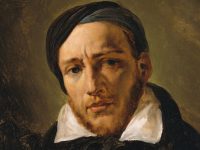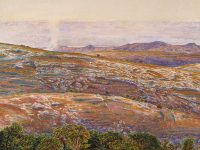From the Idealistic Sublimation of a Landscape to the Nightmare of its Destruction
La cala com a motiu poètic en la literatura de les balears
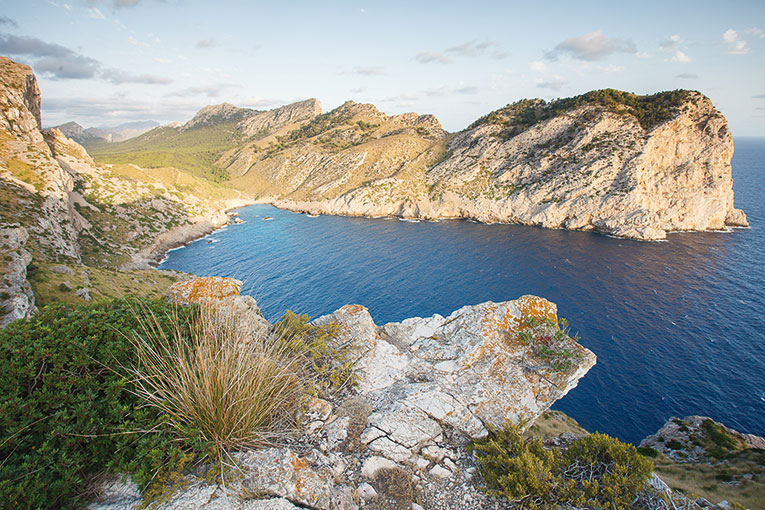
 Sebastià Torrens Sebastià TorrensThe Balearic Islands’ landscape is characterised by the sea and coves dotted along its coastline. Surprisingly, this landform has not received much attention in Balearic poetry. |
||
| One of the great innovations of nineteenth-century painting and literature was the discovery of landscape. In Balearic literature, despite their dominance in the Islands’ landscape, coves are not a main focus of poetry, but do have a special presence. | ||
|
The discovery of landscape Before Miquel dels Sants Oliver came to the conclusion (in Cosecha periodística, 1891) that landscape diversity was a factor of great economic potential, there had been many occasions when, through words or images, island landscapes had been the subject of admiration and praise. In the nineteenth century, numerous European travellers reached coincident diagnosis: they were landscapes of wonder; however, they were inhabited by a society characterised by backwardness. It was the French writer George Sand who, in A Winter in Mallorca (1841), pointed out the strong contrast between the excellence of nature and shortcomings of the social environment. The discovery of landscape –understood as the portion of nature created by humans through the intervention of man’s aesthetic perception in our search for order– was a great innovation in painting and literature of the nineteenth century. Landscape became a first-class artistic subject, and overcame being little more than the backdrop against which historical, religious or mythological scenes were set, as it had been until then –with few exceptions– and to all intents and purposes earned the right of adequacy in meaning and expression. The Romantics endowed nature with attributes unique to the human condition, to the extent nature was conceived as a reflection of the emotions and feelings of self; be the observer poet or painter. The archetypal merely ornamental representations of nature, which were dominant historically, were replaced by others which above all sought uniqueness and originality, both in the physical spaces represented and in their portrayal, making them into artistic creations. Throughout the nineteenth century, the Balearic Island landscapes, and especially Mallorca, were the focus of repeated and widespread attention. Romanticism made a new appreciation of nature fashionable and numerous European travellers –both scholars and romantics– visited the archipelago. This led to a number of publications in which the drawings or engravings accompanying the text portrayed many and diverse images of the islands’ urban and rural or coastal landscapes, which were to gain the status of artistic images. Proof can be found in the ten volumes of Die Balearen (1869-1891) by the Archduke Luis Salvador, and Les îles oubliées (1893) by Gaston Vuillier. Furthermore, during the second half of the century, landscape painting was to become the preferred artistic choice of Balearic painters. Joan O’Neille, Ricard Anckermann and Antoni Ribas are the best proof of this. In general, their paintings take us to mountainous or seaside spots and are, at times, somewhat iconographic, portraying rather picturesque anecdotal customs. However, it was in the first twenty years of the twentieth century that landscape painting in Mallorca reached a state of communion and maximum creativity, especially during the first decade. It was at this time a new way of seeing and representing nature emerged. Due to the assimilation of impressionism and symbolism, painters no longer wished to create relatively realistic and over-descriptive pictures, indeed it was quite the contrary and they attempted, instead, to translate real landscapes into paint, based on visions of subjectivity and on intense emotional and symbolic transfiguration. This was to be the role of the Belgian painter William Degouve Nuncques and Catalans Joaquim Mir and Santiago Rusiñol. Their artworks introduced a new way of looking at the island landscapes and, therefore, they also portrayed them in new colours sought to prioritise the expression of more personal and more complex feelings and emotions. In the wake of these three artists came many more painters who –either temporarily or permanently– turned the island’s landscapes into the focus of their artworks. From among many others, we should mention the Mallorcan Antoni Gelabert, the Catalans Sebastià Junyer and Hermen Anglada-Camarasa and the Argentine Francisco Bernareggi. This fascination with the landscape came to monopolise the pictures painted in Mallorca. Over the years, and especially because there were also a large number of artists whose creativity was below average or even very low, the Balearic landscapes started drifting towards the stereotype and the commonplace, to the point they became stuck in locally influenced and mostly mediocre hegemonic post-impressionism –Guillem Frontera says– until the seventies. |
«Coves have not received much attention in Balearic poetry. The fact is surprising when you consider the number of place names preceded by the noun ‘cala’ lining the shores of the islands» |
|
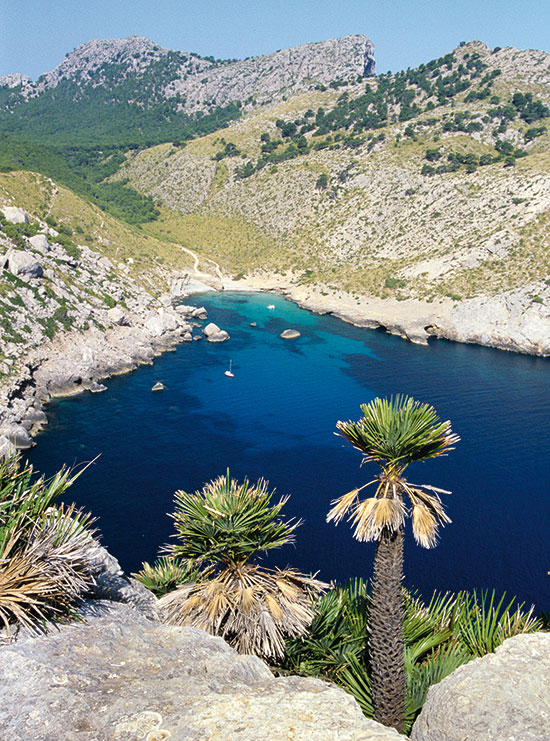 Sebastià Torrens Sebastià TorrensBlai Bonet dedicated the poem La cala (The cove) to Cala Figuera (Santanyí), conveying strong sensory intensity and a host of colour references. |
«It was in the first twenty years of the twentieth century that landscape painting in Mallorca reached a state of communion and maximum creativity. It was at this time a new way of seeing and representing nature emerged» |
|
|
Poets and landscape Balearic lyricism began to reflect landscape as a primary reference with the publication of the first book by Miquel Costa Llobera: Poesies (1885). Beforehand, some poets of the Renaixença (Catalan revivalist movement) had already proffered a number of pieces reflecting their personal experiences of nature. This was sometimes done by providing a panoramic view of the whole island, as described from the Puig Major viewpoint in La Roqueta by Mateu Obrador, or Dalt d’un coll by Marian Aguiló, and at other times by capturing the essence of a specific plant species, as in L’olivera mallorquina and Els tarongers de Sóller, by Josep Lluís Pons Gallarza, or A un ciprer, by Marian Aguiló. Mostly the natural elements comprising the landscape acquire an important symbolic meaning. The most noteworthy case is that of the olive tree, whose image Pons Gallarza turned into a symbol of permanence, contrasting with the fleeting nature of both individual lives and of human civilisations. Costa Llobera captured the romantic landscape of Mallorca in writing with some of his poetic compositions in Poesies, in which verses referring to either inland or coastal spots are abundant. Indeed, these poems are born from the emotional interaction between the lyrical and the environmental. Natural landmarks or elements of nature that are the subject of recreation draw a parallel with the poet’s beliefs and state of mind or way of life, or the one the poet strives towards. The beauty of the landscape as a witness to the perfection of all made by God the Creator: La vall with its seclusion and silence is the most suitable place to conduct an exploration of the inner world; or El pi de Formentor, which becomes a symbol of a higher conception of life, one in which struggling and winning against the odds and the constraints of everyday life to achieve the fullness that can only be born of spiritual and artistic experience. In his reflections of the landscape, Costa Llobera was attracted by Mallorcan mountains and hills on the north coast, and by specific spots that lie between the Gorg Blau and Cape Formentor. It is of a rugged nature, somewhat Wagnerian, with an almost complete absence of the human form. This environment of loneliness is only broken by the intrusion of a poetic voice making it visible. This is the same Mallorca that attracted mostly modernist painters. Joan Alcover’s Cançons de la serra in the volume entitled Cap al tard (1909) reveals that the Mallorcan Serra de Tramuntana also appealed to him, but in this case it is the region running from Deià to Calvià. Here we find nature inhabited by humans, described in the detail of a miniaturist, and internalised through a process of contemplation that has captured it emotionally. In La Serra, his most emblematic landscape poem, nature becomes a symbol of the homeland, and at the same time the reality of a Mediterranean island from classical Arcadian myth. After Costa and Alcover, later poets also gave the landscape preferential treatment. Llorenç Riber rather marked a line of continuity with the poet from Pollença. Maria Antònia Salvà and Miquel Ferrà brought with them substantial changes: the island region of their choice ceased to be the Serra de Tramuntana as they opted for geologically more discreet landscapes, the former preferring southern Llucmajor and the latter Raiguer or Pla. It marked the passage from a Wagnerian backdrop to one favouring the small or simple; and away from the shrill chromatic tones towards rather duller and greyish hues. Many of Salvà’s poems highlight plant elements –for instance Flora humil in the Espigues en flor volume (1926)– and domestic animals of a very modest scale. In the landscape poetry by the authors of the Escola Mallorquina (Mallorcan School) (Guillem Colom, Rafael Ginard, Miquel Colom…) there was, in general, a regressive process in the portrayal of nature: there was a loss of symbolic significance and a return to primarily descriptive compositions. This trend, however, finally ended with the appearance of the first works by the poets of the 1951 generation: Entre el coral i l’espiga (Between Coral and Wheat, 1952) by Blai Bonet, and L’hora verda (1952) by Jaume Vidal Alcover. Again the landscape was immersed in the alchemy of metaphor, of an even more visionary nature, and in all the expressive resources designed to enhance the sensory and subjective perception of the real elements that formed it. A characteristic feature of all Mallorcan literature on the landscape, from Costa Llobera to Blai Bonet, is rapture on beholding nature, which –without exception– ends up undergoing a process of idealistic sublimation. |
«Although the cove motif is not very common in work by the island poets, coves do have a special presence» |
|
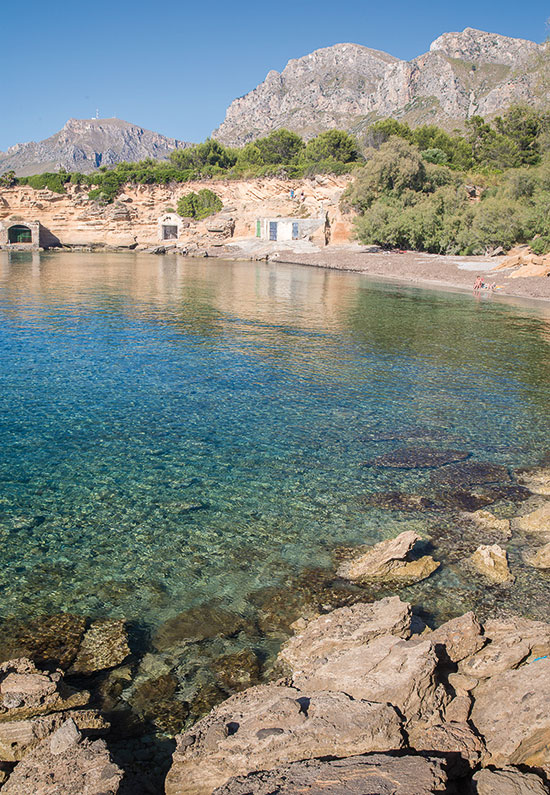 Sebastià Torrens Sebastià TorrensCaloscamps inspired the poet Bartomeu Fiol to write his Calaloscans collection, revealing a change in the literary perception of the landscape. From a landscape of sublime beauty it starts to be characterised negatively. |
«The Romantics endowed nature with attributes unique to the human condition, to the extent nature was conceived as a reflection of the emotions and feelings of self» |
|
|
The cove as poetic motif The cove, a landform characterised by a coastal inlet, has not received much attention in Balearic poetry. This is surprising when you consider the number of names preceded by the noun cala (cove) lining the shores of different islands forming the archipelago. In the first volume of the Corpus de toponímia de Mallorca (1962-1963) Josep Mascaró Pasarius mentions more than a hundred coves, and some sixty calons. Unlike the poets, painters did feel a strong attraction towards coves, especially the one at Deyá –a precedent set by an engraving in the Die Balearen– and also Cala Sant Vicenç. Both were immortalised on large-format canvases by Joaquim Mir. Indeed, in the international context of early twentieth-century painting these artworks could be considered radical in their use of colours and in their distortion of real elements, almost reaching a point of pure abstraction. The northern Mallorcan cove of Sant Vincenç –including the headland known as Cavall Bernat– has been portrayed so many times by so many artists that it is, in itself, a subgenre within the paintings of Mallorcan landscape. However, although the cove motif is not very common in the work of the island poets, one can certainly say that its presence is very select. The first example is Cala Gentil by Costa Llobera. He made a first draft in November 1903, and in July the following year ended the final version. The poem was included in the volume Poesies (1907). The adjective gentle is used by the poet to refer to the cove called Cala del Pi de la Posada, the same place where the well known Hotel Formentor was built in 1920. The poet used to stop off at this spot on his walks through the woods. His composition is the description of a very specific and real beauty spot, with references to the plants, geological surroundings and fluid elements that formed it. To portray this, he makes use of ennobling lexical terms, multi-sensory in nature (visual, olfactory and auditory). The cove is perceived to have a great many attributes: brightness, beauty, happiness, serenity, eternity… This is the literary cliché locus amoenus: a natural landscape nestling between the sea and a curtain of lush vegetation with a mountain ridge rising up in the background. It is the objective correlative of that paradise in which people can find shelter and peace in the face of adversity, and also the fullness of life and inner tranquillity, as well as utmost happiness and that kind of respite and comfort that only comes with the dissolution of self within nature, where nature is perceived as a reflection of divinity. The other great Mallorcan poet from the turn of the century, Joan Alcover, wrote a fanciful composition entitled La sirena or The Mermaid, which then became «a deep cove» on the stage. In this piece a «lone fisherman» and a fish-woman share fleeting physical contact, but both realise that their would-be marriage was an «impossible intercourse». After the Civil War, the cove theme was dealt with by some of our best poets, like the poet from Ibiza, Marià Villangómez. In the book Els dies (1950) we find the four quartets of the deserted cove Cala deserta. The first two, descriptive in nature, respectively refer to the terrestrial and the marine component of any cove. The third refers to the mythical history of the place (demigods, ships, fables), while the fourth tells of the experience of the lyrical self in between the hot summer lands and the cool sea. Entre el coral i l’espiga (1952) by Blai Bonet includes the poem entitled La cala, which transports us to the Cala Figuera de Santanyí. There are four quartets of decasyllabic verses that convey overpowering sensory intensity, and an abundance of colour references and action verbs. In short, the poet weaves a polychrome and dynamic emotionally exalted reality, a pagan pantheism that is confirmed by including the reference to fecundation of Danae by Zeus-sun, transformed into a shower of gold. The climax occurs when marine and solar nature and the physical body of the lyrical self fuse to form a single entity. In his book Comèdia (1960), Blai Bonet again places the evocation of childhood years in the historical context of the Civil War on the seashore, and on the beach of a cove, in whose vicinity different plant elements are described. The poem is complex and long –one hundred and fifty three verses– and is entitled El mar de Montdragó. This text paints Santanyí cove as a backdrop against which the events take place. And we find the same place name again in the first book published by Josep M. Llompart: Poemes de Mondragó (1961). In fact this is the title of the opening section of the volume, consisting of nine poems written in 1955. Llompart and some of his fellow poets made several visits to a summer house located in Mondragó. This was the actual physical experience that gave rise to the texts. Here we find a scarcely naturalist description of the environment. Rather we find an empathetic autumn landscape amid visions of love and signs of melancholy. At times, a certain decaying atmosphere, explicitly suggested by references to facts and concepts, such as the twilight, Ophelia, death, childhood disease … In these poems, the landscape is the objective correlative of the poet’s inner world. Through a tangible material reality the landscape suggests a hidden world, which is emotionally intense and troubled, and romantically stifling. Another Mallorcan poet also chose the name of a cove for the title of his first book. This was Bartomeu Fiol and his collection Calaloscans (1966). The place name, located in the north-eastern part of Mallorca, in the coastal village of Colonia de Sant Pere, in Arta, according to Joan Corominas is the popular name for Caló des Cans. The poet interprets it in this way. More recently, the linguist Cosme Aguiló has adequately established that it must be Caloscamps, a primal Cala los Camps. This work by Fiol represents a shift in the literary tradition of the Balearic landscape. Especially because it darkens the spot described: light and polychrome rendering cease to be the two key attributes. And also, when it comes to representing it, he lays aside current symbolist orchestration and the use of metaphors of exaltation. The landscape is no longer seen with rapture, and, consequently, the poem loses the sense of being an act of almost liturgical celebration. From the sublime beauty of a paradise cove portrayed by Costa, Villangómez, Bonet, Llompart, we now turn to a spot described negatively: «the cove is not pleasant», «rugged bank», «the cursed cove», «the hysterical sea», «the dark cove». In addition, the collection of poems is built with a rugged style, hard, not avoiding the strident sound with unconventional verbal constructions, always with the sound of barking of dogs in the background, with a torn tone closer to expressionist aesthetic. The overall meaning of Calaloscans is diluted between closed and ambiguous verses. Even so, the texts by different analysts in the book show a shared interpretation: the cove is the symbol of a much wider territory, that of Mallorca in the sixties. A decade, in which suffocation under Franco’s regime and a breakdown in traditional rural society, changed the course of history. Ponç Pons, a poet from Menorca, made numerous references to his island’s landscape in his books. In general, his approaches are from a dual and contrasting perspective: on the one hand, the vision of his childhood paradise and, on the other, the nightmare of a present in which nature has been invaded and her identity plundered. In his book El salobre (1997), for example, we find a number of poems documenting this vision ranging from nostalgia for a mythical lost past. The best example is the poem Cala’s Morts (dead coves) and a hostile present «Ja no hi ha vellmarins als penyals de Fornells/ S’omplen totes les cales de bars i de murs» (Obituari)1. Or the contrast found in the poem «Argonauta» between past experiences –«Cant i escric amb amor el nom de boscos purs/ on jugàvem feliços a guerra els amics/ i on anava amb ma mare a cercar esclata-sangs»2– and the present time «Ho record mentre escric abocat a un futur/ estranger encimentat de for rents i de bars»3. Unquestionably, with the verses of the Ponç Pons phenomenon, Balearisation took onboard the literary landscape of the island. Between Miquel Costa Llobera’s Poesies of 1885 and the 1960s with Bonet, Vidal Alcover and Llompart, the Balearic literary landscape was expressed in the idealistic discourse of celebration and sublimation. After Calaloscans del Fiol, there was a shift towards stark representations with nothing inspiring, and so onward to many of Ponç Pons’ verses, in which the islands’ geography was already suffering from the double negative impact: environmental degradation and depersonalised identity. Thus, treatment of the cove as a motif, developed in parallel with the landscape as a whole. 1 «There are no longer seals at Fornells/ all the beaches are full of bars and walls» Back to text.
2 «I sing and write lovingly the name of the pure forests/ where we friends happily played war games/ and where I went with my mother to collect mushrooms» Back to text
3 «I remember as I write looking to the future/ foreigner cement for rents and for bars» Back to text
Bibliography Damià Pons. Full Professor of Catalan. University of the Balearic Islands. |
«Costa Llobera portrays |
|
Bibliografia
Llompart, J. M., 1964. La literatura moderna a les Balears. Moll. Palma.
Llompart, J. M., 1970. Poesía y paisaje. El tema de la “Costa Brava” en los poetas mallorquines. Cort. Palma.
Pons, M., 1998. Poesia insular de postguerra: quatre veus dels anys cinquanta Publicacions de l’Abadia de Montserrat. Barcelona.
Pons, M., 1999. Blai Bonet: el poeta i el paisatge de Santanyí. Ajuntament de Santanyí. Santanyí.

